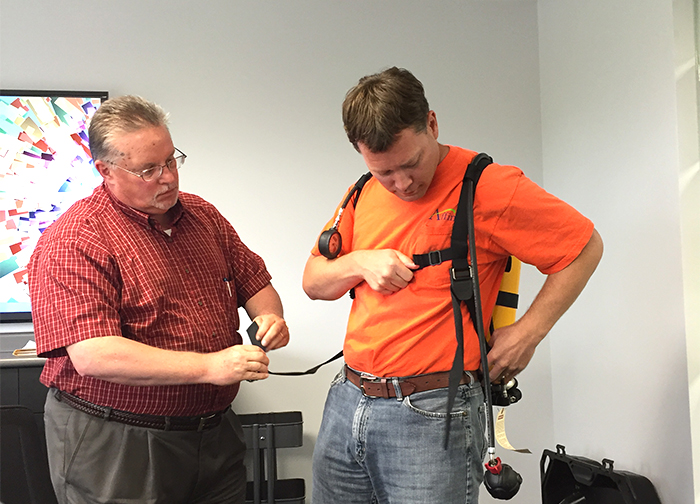Safety Certifications
Posted on Wednesday, May 4th, 2016 by Affinis CorpIn Firm News, Survey, tagged in Tags: aed training, certifications, confined space entry, cpr, first aid, railroad, safety, safety certifications, training

Safety is always a priority at Affinis. But, it is particularly important for those working in the field. Our survey team has first aid, CPR and AED training. They are also trained and certified in confined space entry and railroads. In this post, we’re sharing the importance of each.
First Aid, CPR & AED
We currently provide First Aid, CPR, and AED certification training opportunities to all staff on a bi-annual basis. We offer this as a learning opportunity for developing life-saving skills that can be used on and off the job. All field staff are required to attend this training, so there is a skillset in place should an accident or emergency occur in the field. That is because many times our crews are working in out-of-the-way locations, like when we perform levee inspections. Those are often in remote areas that are not close to a medical facility or emergency response team.
With this training, our staff is able to provide a short term solution in a medical emergency until help arrives. Like levees, the situation for surveys can be similar in terms of remoteness. Two people may be working in the woods a mile from a vehicle, and a person may be injured with no cell phone coverage. People can fall, be bitten by snakes, or cut by a machete. Fortunately, we have not had to be tested in real life situations since getting trained, but are glad we’re prepared for the worst.
Confined Space Entry
All field staff are trained and certified in Confined Space Entry. This training includes other areas, such as fall prevention, air quality monitoring, methods of rescue, proper use of personal protection equipment, and general safety guidelines. Affinis feels it is important co-workers are provided the training and tools to recognize potential hazards when working on job sites. This training allows us to meet our clients’ needs and prevent our team from injury in situations in which untrained persons may not see any danger. An example is entering unventilated structures underground. Most persons are unaware of the potential presence of harmful gases created below the surface and may not think twice about entering a manhole or box culvert to collect information. The training raises awareness of potential risks and allows us to mitigate them and put a safety plan in place before an accident occurs.
Railroad
Safety is the number one priority when working in the field on railroad property. All survey staff have gone through safety training for BNSF Railroad, Union Pacific Railroad, and Kansas City Southern Railroad. The training is generally the same for all railroads; however, each one is specific to each company and taught per their individual guidelines.
When it comes to railroads, there is the need for planning, knowing the nearest medical facility, and pre-work safety meetings, along with other factors that come into play when working in close proximity to such heavy and fast-moving machines. The training points out many hazards that most people just don’t think of. We learned that certain color schemes are not allowed and some are required. An example is that there is to be no red clothing, hats, etc. on persons working on railroad property. The color red signals to the railroad train engineer to stop immediately. Contractors, such as Affinis staff, are to wear lime green stripes on hard hats to identify ourselves as contractors, instead of railroad employees.
Every site visit includes the appointment of an employee-in-charge that documents the safety plan of the day. The training teaches how to work as a “gang” in the vicinity of the railroad. Some tasks require the use of “lookouts” to keep the gang safe while working.
One of the main lessons taught, is what is “fouling the tracks.” Fouling the tracks, or impeding a train, is something that can never be done without communication and planning with the railroad companies and their employees. Miscommunications or misunderstandings can lead to large accidents such as the recent Amtrak accident in Philadelphia. Our training has taught us to use the proper channels of communication to accomplish our work tasks. Surveying on railroad right-of-way does not normally create a need to impede train traffic, but if it should, we would be aware of how to get train traffic stopped for workers safety.
